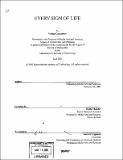| dc.contributor.advisor | Walter Bender. | en_US |
| dc.contributor.author | Gerasimov, Vadim, 1969- | en_US |
| dc.contributor.other | Massachusetts Institute of Technology. Dept. of Architecture. Program in Media Arts and Sciences. | en_US |
| dc.date.accessioned | 2005-09-27T18:16:57Z | |
| dc.date.available | 2005-09-27T18:16:57Z | |
| dc.date.copyright | 2003 | en_US |
| dc.date.issued | 2003 | en_US |
| dc.identifier.uri | http://hdl.handle.net/1721.1/28776 | |
| dc.description | Thesis (Ph. D.)--Massachusetts Institute of Technology, School of Architecture and Planning, Program in Media Arts and Sciences, 2003. | en_US |
| dc.description | MIT Institute Archives copy: pages 151-[182] bound in reverse order. | en_US |
| dc.description | Includes bibliographical references (p. 142-150). | en_US |
| dc.description.abstract | Every Sign of Life introduces an approach to and motivational schema for personal health monitoring. It is an exploration of how to make information collected by personal health-monitoring devices fun and engaging, and consequently more useful to the non-specialist. In contrast to the common methodology of adding game elements to established biofeedback systems, the Every Sign of Life approach is to design and build games that use biosensor information to effect the game environment. This work tests the hypothesis that fun (the joy of learning, achieving, competing, etc.) is a way to achieve the goal of self-efficacy; to induce people to take care of their own health by altering their habits and lifestyles. One result is a basic architecture for personal health-monitoring systems that has led to an approach to the design of sensor peripherals and wearable computer components called "Extremity Computing." This approach is used to redefine biosensor monitoring from periodic to continuous (ultimately saving data over a lifetime). Another result is an approach to adding implicit biofeedback to computer games. This has led to a new genre of games called "Bio-Analytical Games" that straddles the boundary between sports and computer games. A series of studies of how to present health information to children and adults have demonstrated the ability of consumers to use bioinformatics without involving professionals. | en_US |
| dc.description.statementofresponsibility | by Vadim Gerasimov. | en_US |
| dc.format.extent | 181, [1] p. | en_US |
| dc.format.extent | 7526731 bytes | |
| dc.format.extent | 7549854 bytes | |
| dc.format.mimetype | application/pdf | |
| dc.format.mimetype | application/pdf | |
| dc.language.iso | en_US | |
| dc.publisher | Massachusetts Institute of Technology | en_US |
| dc.rights | M.I.T. theses are protected by copyright. They may be viewed from this source for any purpose, but reproduction or distribution in any format is prohibited without written permission. See provided URL for inquiries about permission. | en_US |
| dc.rights.uri | http://dspace.mit.edu/handle/1721.1/7582 | |
| dc.subject | Architecture. Program in Media Arts and Sciences. | en_US |
| dc.title | Every sign of life | en_US |
| dc.type | Thesis | en_US |
| dc.description.degree | Ph.D. | en_US |
| dc.contributor.department | Program in Media Arts and Sciences (Massachusetts Institute of Technology) | |
| dc.identifier.oclc | 60128986 | en_US |
